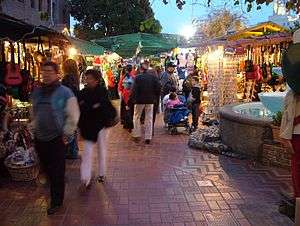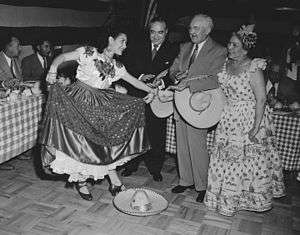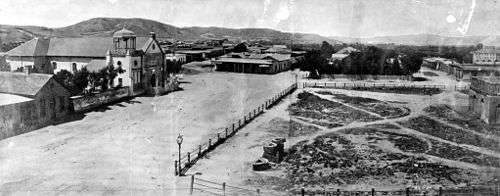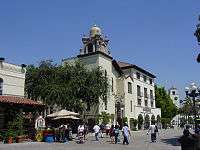Olvera Street
Olvera Street (Calle Olvera or Placita Olvera) is a historic district in downtown Los Angeles, and a part of El Pueblo de Los Angeles Historic Monument. Los Angeles was officially founded in 1781,[1] Olvera Street obtained its current name in 1877. Many of the Plaza District's Historic Buildings are on Olvera Street, as well as some of the oldest Los Angeles monuments including the Avila Adobe built in 1818, Pelanconi House built in 1857, and the Sepulveda House built in 1887. The tree-shaded, pedestrian mall marketplace with craft shops, restaurants and roving troubadours is a popular tourist destination. The street has been described as a "Top Five" in the "Great Streets of America" journal.


History
Early days

Los Angeles was founded in 1781 by Spanish pobladores (settlers),[2] on a site southeast of today's Olvera Street near the Los Angeles River. They consisted of 11 families—44 men, women, and children — and were accompanied by a few Spanish soldiers.[2] They had come from nearby Mission San Gabriel Arcángel[2] to establish a secular pueblo on the banks of the Porciúncula River at the Indian village of Yang-na.[3] The new town was named El Pueblo de Nuestra Señora Reina de los Ángeles. Priests from San Gabriel established an asistencia (a sub-mission), the Nuestra Señora Reina de los Angeles Asistencia, to tend to their religious needs. The pueblo eventually built its own parish church, known today as the "Old Plaza Church." Unpredictable flooding forced the settlers to abandon the original site and move to higher ground in the early 1800s.
Spanish colonial rule lasted until Mexican independence in 1821. This period saw Los Angeles's first streets and adobe buildings. During Mexican rule, which lasted twenty-six years, the Plaza was the heart of a vibrant ethnic Californio community life in Los Angeles and was the center of an economy based upon farming in the former flood plain, supplemented with cattle ranching.
After the Mexican War, the Plaza remained the center of town. A small alley branching off of the Plaza—Wine Street—had its name changed by City Council ordinance in 1877 to Olvera Street to honor Agustin Olvera,[2] the first Superior Court Judge of Los Angeles County, who owned a no longer existing adobe house nearby. In the 1880s, the little town grew rapidly due to the influx of settlers from Southern States. These joined the Spaniards and earlier English-speaking settlers who had become voting citizens before 1846.
As the town expanded, the original area of settlement came to be neglected, and served as a neighborhood for new immigrants, especially Mexicans and Sicilians. It included a Chinese community, which eventually relocated to the present nearby Chinatown to make way for the construction of Union Station. During the 1920s, the pace of Mexican immigration increased rapidly. California was the primary destination, with Los Angeles being a common choice. As a part of a movement to preserve what was viewed as California's "authentic" heritage, Christine Sterling began a public campaign to renovate the Francisco Avila Adobe, which evolved into a campaign to remake Olvera street as a modern Mexican-style market place.
Preservation and restoration
Sterling's efforts to rescue the area began in 1926, when she learned of a plan to demolish the Avila Adobe, the oldest existing home in the city. After raising the issue with the Los Angeles Chamber of Commerce, Sterling approached Harry Chandler, the publisher of the Los Angeles Times, with a plan to create a Mexican marketplace and cultural center in the Plaza. Chandler was intrigued by the idea of packaging the Plaza area that acknowledged the Mexican heritage of the city while presenting a romanticized ersatz version, an ethnic theme park. He helped by providing extensive publicity and supporting the development plan in The Times.
However, by 1928, due to a lack of financial support for implementing her ideas, the project appeared to be doomed. In late November, Sterling discovered a Los Angeles City Health Department Notice of Condemnation posted in front of the Avila Adobe. In response, she posted her own hand-painted sign condemning the shortsightedness of city bureaucrats in failing to preserve an important historic site. Her act helped attract additional public interest in preserving the old adobe. The Los Angeles City Council finally reversed its original order of condemnation. Support for restoring the adobe rushed in from throughout the city. Building materials came from several local companies, including Blue Diamond Cement and the Simmons Brick Company, one of the largest employers of Mexicans in the Los Angeles area. Los Angeles Police Chief James Davis provided a crew of prison inmates to do hard labor on the project. Sterling oversaw the entire construction project, and an excerpt from her diary vividly captures her spirit and sense of desperation for financial support during the construction: "One of the prisoners is a good carpenter, another an electrician. Each night I pray they will arrest a bricklayer and a plumber."

In spite of ample supplies and forced volunteers, the project lacked solid financial backing until Chandler came forward with capital for the project through funds collected at $1,000-a-plate luncheons with selected businessmen. Chandler established and headed the Plaza de Los Angeles Corporation, a for-profit venture which became the financial basis for the restoration of Plaza-Olvera. The street was closed to traffic in 1929.
On Easter Sunday 1930, Sterling's romantic revival came to pass with the opening of Paseo de Los Angeles (which later became popularly known by its official street name Olvera Street). Touted as "A Mexican Street of Yesterday in a City of Today", Olvera Street was an instant success as a tourist site. La Opinión, a leading Spanish language daily, praised the project as "una calleja que recuerda al México viejo" (a street which recalls old Mexico).[4]
Present
In present day, Olvera Street is home to more than three dozen restaurants, vendors, and public establishments. The American Planning Association named it one of the top five "Great Streets" in the United States for 2015. As part of El Pueblo de Los Angeles Historic Monument which is on the National Register of Historic Places, they recognized that it was once the heart of Mexican farming and community life in the area.[5]
Situated in the midst of Downtown in the area where the city was born in 1781, Olvera Street is home to dozens of craft shops, restaurants and businesses with roving troubadours.[6][7] This pedestrian mall is a block-long narrow, tree-shaded, brick-lined marketplace where some merchants are descended from the original vendors who opened shops when Olvera Street was created in 1930. The exterior facades of the brick buildings enclosing Olvera Street and on the small vendor stands lining its center are colorful piñatas, hanging puppets in white peasant garb, Mexican pottery, serapes, mounted bull horns, and oversized sombreros. Olvera Street attracts almost two million visitors per year who can find the customs and trades of the Mexican and Latino traditions of Los Angeles commemorated in an walkable outdoor shopping mall. As a tourist attraction, Olvera Street pays homage to a romantic vision of old Mexico.[8]

The plaza, before it was improved, can be seen in Charlie Chaplin's 1921 film The Kid, which featured a number of scenes of the west side of the plaza a few doors north of the Pelanconi House. At the time of the film, Olvera Street, then still called Wine Street, was seen as a dingy alley.
Controversies
Some find Olvera Street to be a sanitized fabrication of Latin American culture merely to attract tourists, a "fake" Mexican presence; since 1926, it has garnered controversy as historians and collectors have attempted to preserve the sites for historic study and educational purposes. In contrast, there are researchers that often cite that Olvera Street is an "appropriated" misnomer of Latin-American and Hispanic culture, and should therefore not remain as a source of tourism.[9] Even critics though, have acknowledged how the city fathers were ready to condemn and destroy the whole unsightly mess in the 1920s.[10] The attention brought to the area shamed the city into saving its heritage and preserving some of the original adobe buildings.[11] This tension around an idealized cultural image is evident in the mural América Tropical (full name: América Tropical: Oprimida y Destrozada por los Imperialismos, or Tropical America: Oppressed and Destroyed by Imperialism[12]) by David Siqueiros which was slated to be an exciting addition to the street until it was actually unveiled in 1932. The mural was ignored and soon covered up to mask its political content that scandalized L.A. elites. The Getty Conservation Institute began performing detailed conservation work on the mural in 2010 and the America Tropical Interpretive Center opened to provide public access in 2012.[13]
Blessing of the Animals
The Blessing of the Animals at Olvera Street, an event dating to 1930, is held every Sábado de Gloria (Holy Saturday, the Saturday before Easter). The event was originally held in conjunction with the Feast Day of Saint Anthony of the Desert, but it was changed to take advantage of better weather. The original procession has grown into an all-day event with vendors, performers, and a procession where participants bring their animals to be blessed by religious authorities and others.
The event includes an animal parade and informal displays of their pets[14] and the event was covered in the book Blessing of the Animals: A Guide to Prayers & Ceremonies Celebrating Pets & Other Creatures.[15]
Characteristics
Location
Olvera Street is located in the east of modern-day Downtown Los Angeles, adjacent to both Union Station and Chinatown. It sits between Main and Alameda Street. Olvera Street consists of the Plaza and its parish church, with an alleyway branching from the main area; the street itself is home to vendors, restaurants, and historic sites and information.
Plaza
The Plaza, adjacent to the alleyway of Olvera Street, is home to the origins of the city of Los Angeles. It is the forefront to the original Old Plaza Church, and has since housed street vendors, performance, and festivities.
Avila Adobe
The Avila Adobe is a housing structure located on Olvera Street, and is the oldest standing residence in the city of Los Angeles. It was built in 1818 by Francisco Avila, and has since then been registered as a California Historic Landmark. It was restored starting 1926 through efforts by Christine Sterling, and now stands as a museum.[16]
Sepulveda House
The Sepulveda House is a historic residence built in 1887 by Señora Eloisa Martinez de Sepulveda. It has since then become a preserved museum, and is cited by its website as a representation of the "blending of Mexican and Anglo culture".[17]
Eloisa Martinez de Sepulveda was born in the state of Sonora in Mexico. She lived there until 1844 when her parents, Francisca Gallardo and Estaquio Martinez, moved to Alta California at the urging of Francisca’s brother, bringing the 11-year-old Eloisa and her older brother Luis, with them to Los Angeles. In 1847, Senora Francisca Gallardo received from the ayuntamiento (Common Council) a plot of land between Bath and Wine street (renamed Olvera Street in 1877) on which she constructed an adobe residence. Senora Gallardo’s adobe home at number 12 Bath Street was later enlarged to include by 1870 a second story and hipped roof. When Eloisa married Joaquin Sepulveda at the age of 23, she brought with her a dowry of land and cattle. Joaquin was an undistinguished member of an illustrious Southern California family. Sadly, the marriage suffered from misfortune as the couple’s only child died in infancy and Joaquin himself died in 1880 leaving no property. Senora Gallardo gave her property to her widowed daughter, Eloisa Martinez de Sepulveda, in 1881. On lands owned by her mother, Eloisa was able to finance the construction of a commercial building which provided her with a steady income. This was the Sepulveda Block, built in 1887.
Senora Eloisa Martinez de Sepulveda built the two story Sepulveda Block in 1887 in response to the city’s real estate and population boom of the 1800s. The twenty-two room building cost $8,000 to erect. As her husband, Joaquin Sepulveda, had died seven years earlier leaving no estate, Senora Sepulveda probably financed the construction of the building on her own. By 1888 Bath Street had been renamed Main Street and the city had realigned and widened it, cutting off 18 feet (5.5 m) from the front of the adobe. Senora Sepulveda received $1,190 in compensation.
When the Sepulveda Block was built in 1887 Senora Eloisa Sepulveda kept a suite of three rooms for her own use. Her bedroom reveals much about her Mexican heritage and the popular tastes and styles of the time. It would also reflect some of the places in Los Angeles in the decades following her arrival from Sonora in 1844. The décor of the room shows a practical acceptance of modern technology and contemporary fashion, with its mass-produced walnut furniture and gaslight chandelier. The bedroom has three different wallpapers and a typical flowered carpet. The somewhat cluttered appearance is characteristic of the period and a sign of modest prosperity. By contrast, the brass bed with its draperies and fancy spread, the Chinese shawl, and the well-tended shrine are representative of Senora Sepulveda’s Mexican upbringing and her strong religious beliefs. The large crucifix is on loan from Senora Sepulveda’s descendants while the bed belonged to the Avila family, who were related to her by marriage. The pastel portrait is of her favorite niece, Eloisa Martinez de Gibbs.
Senora Sepulveda chose American architects George F. Costerisan and William O. Merithew to design her two story business block for residential and commercial rental in 1887. Although this particular type of building is probably unique in Los Angeles today, it was a “pattern book” building of a style that was common all over the country at the time. An exception in this building is the typically Mexican breezeway which separates the Main Street stores from the dwelling rooms in the rear. Thus, the Sepulveda Block represents the transition in Los Angeles from Mexican to a combination of Anglo and Mexican styles. The work “block” is the Victorian term for a large commercial building. By this time the city had changed from a Mexican pueblo with a cattle-based economy to an American town with an agricultural economy. The population had grown from less than 2000, most of whom were Mexican, to over 50,000, only 19% of whom were Mexican. When the building was constructed it appears that Senora Sepulveda herself occupied the three residential rooms located in the rear, facing Olvera Street, then an unpaved alley. Later, she may have occupied other quarters. Commercial tenants were located in the stores fronting on Main Street while the second floor was used as a boarding house.
Senora Sepulveda bequeathed the building on her death in 1903 to her favorite niece and goddaughter, Eloisa Martinez de Gibbs. Edward Gibbs, an engineer and lumber company owner, had been a tenant in the Sepulveda Block. In 1888, the same year that he and Eloisa were married, Edward was elected to the City Council. Four of their five children were born in the second floor facing Main Street on the south side. In 1905, along with many other residents of the area, the Gibbs moved to a more fashionable neighborhood in Los Angeles. Succeeding generations of the Gibbs family operated the Gibbs Electrical Company and retained ownership of the Sepulveda Block until it was acquired by the State of California for $135,000 in 1958 as part of the Pueblo de Los Angeles State Historic Monument.
Between 1982 and 1984 major restoration took place in the Sepulveda Block. The building was structurally stabilized and plumbing, heating, air conditioning and electrical systems were installed. A new roof replaced the old one and the front staircase, which had been removed in the 1930s, was put back. The iron cresting is restored as are the red tin tiles over the bay windows. The west façade is “penciled” in the style of the period, meaning that the bricks are painted and mortar lines are traced in white on top. The east façade on Olvera Street, although not originally painted, had previously been sandblasted, a process which destroys the outer surface of the brick, making it porous. As paint provides bricks with protective coating, they have been painted with the color which was first used in 1919. A 1983 archeological excavation beneath the wooden floor unearthed artifacts relating to the building’s history. Peter Snell, partner with Long Hoeft Architects and Gus Duffy Architect, were the firms responsible for the Sepulveda Block restoration plans and construction supervision.
During World War II the Sepulveda Block became a canteen for servicemen and three Olvera Street merchants were located in the building. The building continued to be used by Olvera Street merchants until 1881 when they were relocated for the building’s restoration. Today, El Pueblo Park’s Visitor’s Center is located in the south store on the ground floor. This room represents the Victorian Eastlake style of 1890. Restoration plans call for the creation of an 1890s grocery store on the north side of the first floor.
Representation in other media
- "Golondrina",[18] an opera by Lindsey C. Harnsberger was composed in 2015 to a libretto by Robert Cartland. The opera, originally titled "Olvera Street," was premiered by Vineyard Touring Opera Company (VTO) in November 2017 in Los Angeles, Santa Monica, and South Pasadena, California. It was revised and retitled in 2017 for April and May performances by VTO in Glendale and South Pasadena, California. The story of the opera is based on Christine Sterling's fight to save the Avila Adobe and later restore Olvera Street.
See also
- Avila Adobe
- La Iglesia de Nuestra Señora Reina de los Angeles
- LA Plaza de Cultura y Artes
- Pueblo de Los Angeles
- Rancho Camulos
- Rancho San Francisco
- Zanja Madre
- History of Los Angeles
- List of Registered Historic Places in Los Angeles
References
- Chisholm, Hugh, ed. (1911). . Encyclopædia Britannica. 17 (11th ed.). Cambridge University Press. p. 14.
- Federal Writers' Project of the Works Progress Administration of Northern California (1939). California: A Guide to the Golden State. New York: Hastings House. p. 210. Retrieved 31 May 2018.
- Yenne, Bill (2004). The Missions of California. San Diego, CA.: Thunder Bay Press. ISBN 1-59223-319-8.
The "pobladores" were mostly of mixed raced ancestry, which included Spanish, Indian, and even African
- "La Opinión | Últimas Noticias de Los Ángeles, EEUU, y El Mundo". laopinion.com (in Spanish). Retrieved 2016-12-14.
- Branson-Potts, Hailey (October 2, 2015). "L.A.'s Olvera Street recognized as a top 'Great Street' in America". Los Angeles Times.
- Brooks, Nancy Rivera (November 29, 1991). "NEIGHBORHOOD SHOPPING : Olvera Street: The Flavors of Mexico". Los Angeles Times.
- Sewell, Abby (October 28, 2014) "Downtown's development boom nears historic Olvera Street" Los Angeles Times
- Marshall, Colin (November 5, 2013) "A Los Angeles Primer: Olvera Street" KCET Departures blog
- Kropp, Phoebe (2001). "Citizens of the Past? Olvera Street and the Construction of Race and Memory in 1930's Los Angeles". Radical History Review. 81: 34–60.
- Parra, Alvaro (September 13, 2013) "Olvera Street: The Fabrication of L.A.'s Mexican Heritage" KCET What's in a street name
- Morrison, Patt (October 10, 2012) "Olvera Street's missing mural, then and now" Los Angeles Times
- Del Barco, Mandalit. Revolutionary Mural To Return To L.A. After 80 Years. npr. October 26, 2010. Retrieved June 18, 2015.
- Hernandez, Daniel (September 22, 2010) "America Tropical': A forgotten Siqueiros mural resurfaces in Los Angeles [Updated]" Los Angeles Times
- Rondeau, Ginette Calendar Archived 2014-10-28 at the Wayback Machine Olvera Street Website Accessed 15 November 2014
- "Blessing of the Animals: A Guide to Prayers & Ceremonies Celebrating Pets & Other Creatures". Archived from the original on 2010-10-27. Retrieved 2010-07-13.
- California, California State Parks, State of. "AVILA ADOBE". ohp.parks.ca.gov. Retrieved 2016-11-25.
- "Sepulveda House : El Pueblo De Los Angeles : The City of Los Angeles". elpueblo.lacity.org. Archived from the original on 2016-12-20. Retrieved 2016-11-25.
- Kreuzer, Nikki (2015-05-10). "Offbeat L.A.: The Oldest Surviving Los Angeles Restaurants… A Master List of the Vintage, Historic and Old School". The LA Beat. Retrieved 2020-06-09.
La Mision was renamed La Golondrina, after a popular Mexican song. It is located in the oldest brick building in LA, Pelanconi House, which was built in 1855.
External links
| Wikimedia Commons has media related to Olvera street. |
- Olvera Street Merchants Olvera Street
- El Pueblo de Los Angeles Historical Monument. City of Los Angeles.
- Guerrero, Diana L. Blessing of the Animals, 2007
_edit1.jpg)